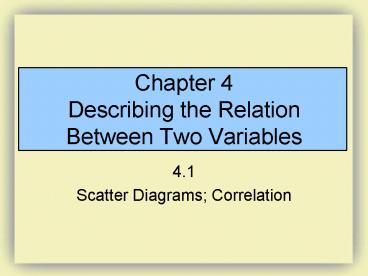Chapter 4 Describing the Relation Between Two Variables PowerPoint PPT Presentation
1 / 30
Title: Chapter 4 Describing the Relation Between Two Variables
1
Chapter 4Describing the Relation Between Two
Variables
- 4.1
- Scatter Diagrams Correlation
2
Objectives
- Draw scatter diagrams
- Interpret scatter diagrams
- Understand the properties of the linear
correlation coefficient - Compute and interpret the linear correlation
coefficient.
3
Bivariate Data
Bivariate data is data in which two variables are
measured on an individual. Do you want to use
the value of one variable to predict the value of
the other variable? If so, how will we do this?
The response variable is the variable whose value
can be explained or determined based upon the
value of the predictor variable.
4
Bivariate Data
- Remember that if the type of data we collect is
observational, we can not conclude a causal
relation. - Also sometimes it is not clear which is the
predictor variable and which is the response
variable. - A lurking variable is one that is related to the
response and/or predictor variable, but is
excluded from the analysis
5
Scatter Diagrams
- A scatter diagram shows the relationship between
two quantitative variables measured on the same
individual. - Each individual in the data set is represented by
a point in the scatter diagram. - The predictor variable is plotted on the
horizontal axis (x) and the response variable is
plotted on the vertical axis (y). - Do not connect the points when drawing a scatter
diagram.
6
EXAMPLE Drawing a Scatter Diagram
The following data are based on a study for
drilling rock. The researchers wanted to
determine whether the time it takes to dry drill
a distance of 5 feet in rock increases with the
depth at which the drilling begins. So, depth
at which drilling begins is the predictor
variable, x, and the response variable, y is the
time (in minutes) to drill five feet. Draw a
scatter diagram of the data. Source Penner, R.,
and Watts, D.G. Mining Information. The
American Statistician, Vol. 45, No. 1, Feb. 1991,
p. 6.
7
(No Transcript)
8
(No Transcript)
9
Interpreting Scatter Diagrams
- Since scatter diagrams show the type of relation
that exists between two variables, our goal is to
determine if there exists a - linear relation,
- a non-linear relation
- or no relation.
- The next 2 slides show the various scatter
diagrams and the type of relation implied.
10
(No Transcript)
11
Interpreting Scatter Diagrams
12
Interpreting Scatter Diagrams
- Two variables that are linearly related can be
positively associated or negatively associated. - They are positively associated when above average
values of one variable are associated with above
average values of the corresponding variable. - That is, two variables are positively associated
when the values of the predictor variable
increase, the values of the response variable
also increase.
13
Interpreting Scatter Diagrams
- Two variables that are linearly related are said
to be negatively associated when above average
values of one variable are associated with below
average values of the corresponding variable. - That is, two variables are negatively associated
when the values of the predictor variable
increase, the values of the response variable
decrease.
14
Correlation
The linear correlation coefficient or Pearson
product moment correlation coefficient is a
measure of the strength of linear relation
between two quantitative variables. We use the
Greek letter ? (rho) to represent the population
correlation coefficient and r to represent the
sample correlation coefficient. We will only do
the sample correlation coefficient.
15
Correlation
- Where r is the sample correlation coefficient
- Xi is the data value for the predictor variable,
- X bar is the sample mean for the predictor
variable, - Sx is the standard deviation for the predictor
variable - yi is the data value for the response variable,
- y bar is the sample mean for the response
variable, - Sy is the standard deviation for the response
variable and - n is the number of individuals in the sample.
16
Properties of the Linear Correlation Coefficient
1. The linear correlation coefficient is always
between -1 and 1, inclusive. That is, -1 lt r lt
1. 2. If r 1, there is a perfect positive
linear relation between the two variables. 3. If
r -1, there is a perfect negative linear
relation between the two variables. 4. The closer
r is to 1, the stronger the evidence of positive
association between the two variables. 5. The
closer r is to -1, the stronger the evidence of
negative association between the two variables.
17
Properties of the Linear Correlation Coefficient
6. If r is close to 0, there is evidence of no
linear relation between the two variables.
Because the linear correlation coefficient is a
measure of strength of linear relation, r close
to 0 does not imply no relation, just no linear
relation. 7. It is a unitless measure of
association. So, the unit of measure for x and y
plays no role in the interpretation of r.
18
Correlation Coefficient
19
Correlation Coefficient
20
Correlation Coefficient
21
Correlation Coefficient
22
Correlation Coefficient
23
Correlation Coefficient
24
Correlation Coefficient
25
Correlation Coefficient
26
Correlation Coefficient
- So the correlation coefficient describes the
strength and the direction of the linear
relationship between a predictor variable and a
response variable.
27
EXAMPLE Determining the Linear Correlation
Coefficient Determine the linear correlation
coefficient of the drilling data.
28
(No Transcript)
29
Sum8.501037 / 11 .773
30
EXAMPLE Determining the Linear Correlation
Coefficient
r .773 This is a linear correlation coefficient
that implies a POSITIVE association. Note that
it only applies an association not causation. A
linear correlation coefficient computed using
observational data does not imply causation among
the variables.

